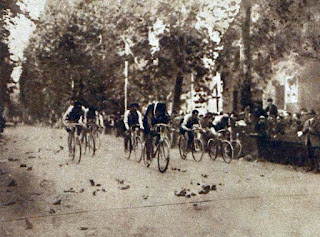2021 edition was 115th since inception
 |
| The finish of the 1911 Giro di Lombardia in Milan, won by Henri Pélissier of France |
The last of the cycling calendar’s five ‘Monuments’ - the races considered to be the oldest, hardest and most prestigious of the one-day events in the men's road cycling programme - the Giro di Lombardia is has also been called the Autumn Classic or la classica delle foglie morte - the classic of the dead (falling) leaves.
It is a particular favourite with cyclists who excel on hill climbs, its changing route normally featuring five or six notable ascents, of which the Madonna del Ghisallo, the site of a church that has become a sacred place in the cycling world, is a permanent fixture.
The race was the idea of journalist Tullio Morgagni, well known as the founder of the Giro d’Italia, although the Giro di Lombardia predated the former by three years.
The editor of the Milan newspaper La Gazzetta dello Sport, Morgagni came up with the idea to give Piero Albini, a Milanese rider, an opportunity to avenge his defeat by rival Giovanni Cuniolo in an event called the Italian King’s Cup.
 |
| Alfredo Binda, who won the race between 1925 and 1931 |
Although the course varied and climbs were gradually introduced, it was not until 1961, when the decision was taken to move the finish to Como, 50km (31 miles) north of Milan, that the race began to take on the characteristics that define it today.
The long and flat run-in to the finish in Milan was replaced with a lakeside finish preceded by a steep descent, the finish line just 6km (3.7 miles) from the pinnacle of the final climb. The race ended in Como from 1961 to 1984, ran from Como to Milan until 1989 and subsequent courses have seen the race finish in Monza, Bergamo, Lecco and Como, with Varese, Cantù and, between 2004 and 2006, Mendrisio in Switzerland added to the starting points.
Since 2014, the race has followed a course between Bergamo and Como, with the start alternating between one and the other.
The race distance varies depending on the route. The first edition, won by Giovanni Gerbi, covered 230.5km (143 miles); of 55 starters, 12 completed the course. The latest staging, in October this year and won by Tadej Pogačar of Slovenia - pipping Italy's Fausto Masnada on the finish line - was over 239km (149 miles); 25 teams of seven riders each participated. |
| Vincenzo Nibali is the most recent Italian winner of Il Lombardia, finishing first in 2015 and 2017 |
Not surprisingly, Italian riders have dominated the event over the years, winning the race 69 times, followed by Belgium and France with 12 victories each. Between 1920 and 1951 there was an unbroken run of Italian successes, including four wins each for Alfredo Binda and Fausto Coppi. The latter’s fifth triumph in 1954 makes him the Lombardia’s most successful rider of all time.
Tom Simpson (1965) remains the only Great Britain rider to win the race, although the Republic of Ireland’s Sean Kelly was a three-times winner in the 1980s and 90s. The Italian dominance began to wane around 1960, and although there was a renaissance in the early part of this century, since 2009 only Vincenzo Nibali (2015 and 2017) has taken first place for the home nation.
The race has been billed as Il Lombardia since 2012 and the 2021 edition was the 115th. Of all the classics, it has suffered the fewest cancellations. It continued throughout World War One and was suspended for only two years in World War Two, in 1943 and 1944. The 2020 staging took place two months earlier than usual, in August, after the cycling calendar was redrawn because of the Covid-19 pandemic.
Travel tip:The Church of the Madonna del Ghisallo
has become a shrine for cyclists
The Madonna del Ghisallo takes its name from an apparition of the Virgin Mary that the medieval Count Ghisallo claimed saved him when he was being attacked by bandits. The Madonna became the patroness of cyclists at the suggestion of a local priest after the hill upon which a shrine to the Madonna was built was included in the Giro di Lombardia and later the Giro d'Italia. The Church of the Madonna del Ghisallo honours cyclists who have died in competition and an adjoining museum contains many bikes and shirts worn by riders down the years.
Travel tip:The imposing walls of Bergamo's Città Alta
were built by the Republic of Venice
The city of Bergamo, which has alternated as the starting and finishing point for Il Lombardia in recent years, has a rich history and boasts some beautiful architecture. The walled Città Alta - the upper town - is a well preserved network of cobbled streets and mediaeval buildings, at the centre of which is Piazza Vecchia, one of Italy’s most beautiful squares. The elegant but more modern Città Bassa - the lower town - is connected to the upper part by a funicular railway. The impressive walls of the Città Alta were built in the 16th century when Bergamo belonged to the Republic of Venice, in order to protect the city from the Milanese and the French.
Also on this day:
1892: The birth of World War One pilot Giulio Lega
1948: The death of composer Umberto Giordano
2011: The resignation of prime minister Silvio Berlusconi

